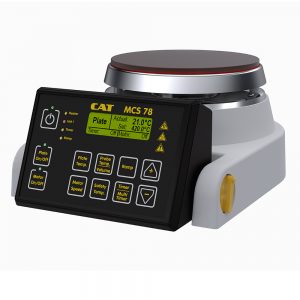Magnetic Hotplate Stirrer Safety
Few pieces of equipment are more fundamental to the daily operations of a laboratory than magnetic hotplate stirrers. Granted, a digital magnetic hotplate stirrer from CAT Scientific is actually a sophisticated piece of sturdy, well-engineered machinery. But its functions, and uses, are fairly simple and straightforward.
These devices have been standard in laboratories for many decades. They streamline a task that once required tedious manual labor. More recently, manufacturers have incorporated digital interfaces and operations, to make these humble devices even more useful for achieving rapid mixing of disparate liquids, and thorough dissolution of solids in liquids.
Avoiding Overheating and Related Hazards
 As with virtually any other piece of laboratory equipment, the safe use of these devices requires careful adherence to certain safety recommendations. Perhaps the most obvious risk involves the hotplate function. These devices are capable of achieving relatively high temperatures, so they represent a potential burn — or ignition — hazard. Obviously, it is crucial to avoid stirring — and heating — inflammable liquids which might be ignited by excessive temperatures.
As with virtually any other piece of laboratory equipment, the safe use of these devices requires careful adherence to certain safety recommendations. Perhaps the most obvious risk involves the hotplate function. These devices are capable of achieving relatively high temperatures, so they represent a potential burn — or ignition — hazard. Obviously, it is crucial to avoid stirring — and heating — inflammable liquids which might be ignited by excessive temperatures.
Other potential safety considerations involve splashing of potentially caustic liquids, or allowing the liquid to evaporate and leave you with an empty vessel, prone to breakage. Digital magnetic hotplate stirrers from CAT Scientific are pre-programmed with security mechanisms, such as Safety Temperature settings, which will automatically shut off the hotplate function, and even Safety Stir Time, which keeps the gradually cooling liquid stirred temporarily, for a preset length of time, in order to prevent uneven heat accumulation and to help the liquid dissipate excess heat.
Leakage Detection
A Differential Alarm is preprogrammed to detect a precipitous drop in temperature, which could signal breakage of the vessel and leakage of the liquid. The hotplate function stops immediately in this scenario, while the stir function continues, to ensure even cooling of the remaining liquid. Still other safety functions involve the use of the Pt100 temperature probe.
If the device detects that the temperature of the liquid does not appear to be rising, despite the hotplate being on, the Out of Liquid function will switch off the hotplate. These preset parameters can be adjusted manually, in order to avoid triggering these default actions inappropriately. Hotplate Temperature Limit is another parameter you can adjust to ensure safe operation. This upper limit can be stored permanently, or set for single-time use.
Miscellaneous Concerns
Some safe-use recommendations fall under the heading of common sense. Because normal operations involve the generation of a strong magnetic field, typical warnings regarding pacemakers and exposure to magnetic fields apply. Be aware that if you have a cardiac pacemaker, it may be unsafe for you to operate this instrument. Similarly, you should not expose digital storage media to this field, as it may corrupt any data stored there.
Other common sense safety concerns involve the potential for burns and risk of explosion. The hotplate may reach up to 500° C. Obviously, this is far hotter than the minimum required to cause a severe burn. Stirring inflammable or otherwise explosive liquids is obviously dangerous and should not be attempted. In fact, the device should not be operated even in the vicinity of such liquids. Finally, safety recommendations regarding appropriate use of gloves, gowns, and other forms of protective clothing should be observed whenever mixing potentially caustic or reactive liquids, or when working with potential pathogens.
